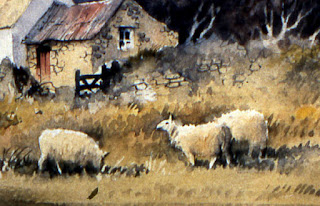Jenny and I have just returned from a tour of demonstrating in Yorkshire, to a number of really enthusiastic art societies who gave us a marvellous welcome, as indeed they usually do in Yorkshire. In between we managed some walking, sketching and visiting people. Lovely weather, of course, that is, until we went out sketching and walking!
This scene of stunning evening light we came across in Wharfedale as we were driving along, the stormy sky emphasising the brightness of the incredibly strong light. Rather like a snow scene with a dark sky, watercolourists would normally paint the sky after rendering the light hillside, but how would you cope with such a sharp edge all the way across the composition?
The answer is actually in the photograph if you examine it closely. On the extreme left-hand side the light does not actually reach the topmost part of the hill – a thin slither of the upper section lies in shadow, and you can accentuate this by making the shadow area larger and having a shadow tone about halfway between the dark sky and the light part of the hill. Then again, on the right-hand side the hill-top is in darker shadow, creating counter-change with the lighter sky above it. The larger right-hand tree also breaks up the background line very effectively. It’s an extremey useful exercise to consider these things when you are presented with interesting features, and take photographs and sketches even if they don’t give you a completely satisfactory composition. You can always use the effects in another scene.





